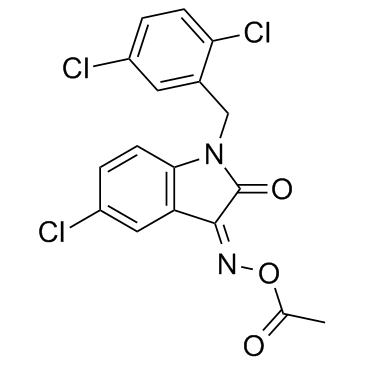668467-91-2
| Name | 1H-Indole-2,3-dione, 5-chloro-1-[(2,5-dichlorophenyl)methyl]-, 3-(O-acetyloxime) |
|---|---|
| Synonyms |
(3Z)-3-(Acetoxyimino)-5-chloro-1-(2,5-dichlorobenzyl)-1,3-dihydro-2H-indol-2-one
3-(Acetoxyimino)-5-chloro-1-(2,5-dichlorobenzyl)-1,3-dihydro-2H-indol-2-one 1H-Indole-2,3-dione, 5-chloro-1-[(2,5-dichlorophenyl)methyl]-, 3-(O-acetyloxime) LDN-57444 |
| Description | LDN-57444 is a reversible, competitive and site-directed inhibitor of ubiquitin C-terminal hydrolase L1 (UCH-L1), with an IC50 of 0.88 μM and a Ki of 0.40 μM; LDN-57444 also suppresses UCH-L3 activity, with an IC50 of 25 μM. |
|---|---|
| Related Catalog | |
| Target |
IC50: 0.88 μM (UCH-L1), 25 μM (UCH-L3)[1] Ki: 0.40 μM (UCH-L1)[1] |
| In Vitro | LDN-57444 is a reversible, competitive inhibitor of UCH-L1, with an IC50 of 0.88 μM, and also suppresses UCH-L3 activity, with an IC50 of 25 μM[1]. LDN-57444 (LDN, 5 μM for 1 hr) inhibits 70% of Uch activity in hippocampal slices of the mouse brain. LDN-57444 (5 μM for 2 hr) does not reduce potentiation further in APP/PS1 slices or in wt slices exposed to 200 nM Aβ[2]. LDN-57444 (25-100 μM) inhibits ubiquitin-proteasome activity dose-dependently in SK-N-SH cells. LDN-57444 (50 μM) also induces apoptotic cell death, causes the endoplasmic reticulum stress and results in expression of spliced XBP-1(XBP-1s, 48KD) in SK-N-SH cells[3]. |
| In Vivo | LDN-57444 (0.4 mg/kg, i.p.) blocks the beneficial effect of V-Uch-L1, and worsens contextual conditioning performance as the mice are exposed to the context at 1, 7, 14, and 21 days after training[2]. |
| Kinase Assay | To start an assay, 0.5 μL of 5 mg/mL test compound (including LDN-57444, about 50 μM final reaction concentration) or DMSO control is aliquoted into each well. Both enzyme and substrate are prepared in UCH reaction buffer (50 mM Tris-HCl [pH 7.6], 0.5 mM EDTA, 5 mM DTT, and 0.5 mg/mL ovalbumin). 25 μL of 0.6 nM UCH-L1 is then added to each well except substrate control wells, followed by plate shaking for 45-60 s on an automatic shaker. The enzyme/compound mixture is incubated at room temperature for 30 min before 25 μL of 200 nM Ub-AMC is added to initiate the enzyme reaction. The reaction mixture (300 pM UCH-L1, 100 nM Ubiquitin-AMC with 2.5 μg test compound) is incubated at room temperature for 30 additional minutes prior to quenching the reaction by the addition of 10 μL 500 mM acetic acid per well. The fluorescence emission intensity is measured on a LJL Analyst using a coumarin filter set (ex = 365 nm, em = 450 nm) and is subtracted by the intrinsic compound fluorescence to reveal the enzyme activity. A DMSO control (0.5 μL of DMSO, 25 μL of UCH-L1, 25 μL of ubiquitin-AMC, 10 μL of acetic acid), enzyme control (25 μL of UCH-L1, 25 μL of buffer, 10 μL of acetic acid), substrate control (25 μL of buffer, 25 μL of ubiquitin-AMC, 10 μL of acetic acid), and inhibitor control (0.5 μL of ubiquitin aldehyde [100 nM stock], 25 μL of UCH-L1, 25 μL of ubiquitin-AMC, 10 μL of acetic acid) are also performed in each assay plate to ensure quality and reproducibility. The UCH-L1 enzymatic reactions are manually repeated twice using the same protocol to confirm the results for the hit compounds from the primary robot-assisted screen[1]. |
| Cell Assay | Cell viability is measured by a quantitative colorimetric assay with MTT. After drug treatment SK-N-SH cells are incubated for 4 h with 5 g/L MTT and then DMSO is added for 15 min. The absorption is quantified at 570 nm using a micro-plate reader[3]. |
| Animal Admin | Each animal is placed individually into the conditioning chamber. The electric current is gradually increased (0.1 mA for 1 sec. at 30 sec. intervals increasing the shock intensity by 0.1 mA to 0.7 mA). Animal behavior is evaluated for the first visible response to the shock (flinch), the first extreme motor response (run/jump), and the first vocalized distress (scream). Threshold to flinching, jumping, and screaming is quantified for each animal by averaging of the shock intensity at which each animal manifests a behavioral response of that type to the foot shock. Visual, motor, and motivation skills are also tested with visible platform training by measuring the time and the speed to reach a visible platform placed within a pool filled with water. Both time to reach the platform and swimming speed are recorded and analyzed with a video tracking system. No difference is observed among different groups of mice in the experiments in which fear conditioning is tested both in the presence of LDN-57444 (LDN) and TAT fusion proteins. To decide the time of administration of LDN-57444, a series of preliminary experiments are performed in which the inhibitor is injected intra-peritoneally at different intervals (4 hrs before, 1 hr before, 1 hr after and 4 hrs after) from the electric shock. During the training phase, there is no difference in the freezing of LDN-57444- or vehicle-injected mice[2]. |
| References |
| Density | 1.5±0.1 g/cm3 |
|---|---|
| Boiling Point | 534.4±60.0 °C at 760 mmHg |
| Molecular Formula | C17H11Cl3N2O3 |
| Molecular Weight | 397.640 |
| Flash Point | 277.0±32.9 °C |
| Exact Mass | 395.983521 |
| PSA | 58.97000 |
| LogP | 4.70 |
| Vapour Pressure | 0.0±1.4 mmHg at 25°C |
| Index of Refraction | 1.655 |
| Storage condition | Desiccate at +4°C |
| Water Solubility | DMSO: soluble16mg/mL |
| Symbol |

GHS09 |
|---|---|
| Signal Word | Warning |
| Hazard Statements | H410 |
| Precautionary Statements | P273-P501 |
| Hazard Codes | N |
| Risk Phrases | 50/53 |
| Safety Phrases | 60-61 |
| RIDADR | UN 3077 9 / PGIII |
